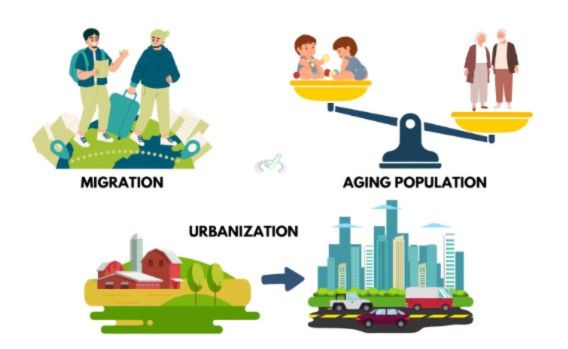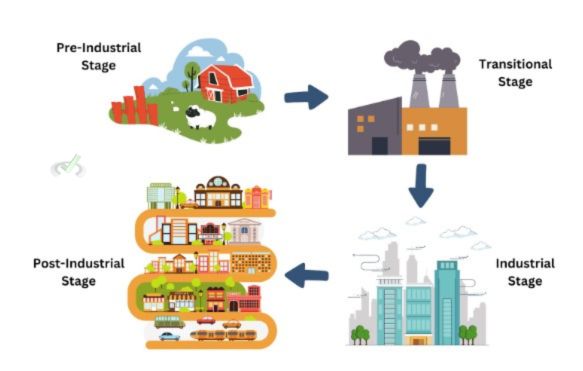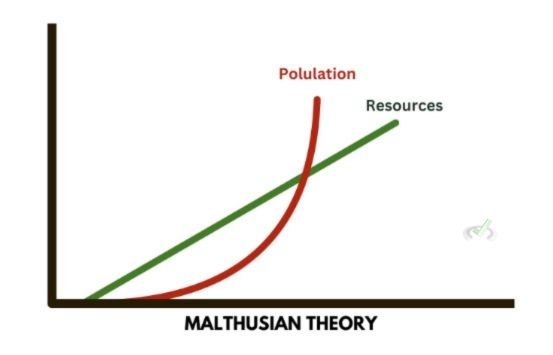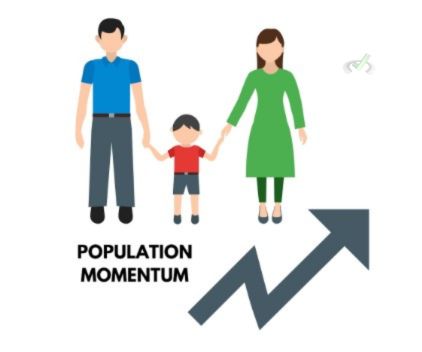Think about the changes you've noticed in your town or city over the years. Maybe there are more older adults now, or perhaps you've seen a rise in new families moving in.
These population changes are called demographic shifts. Understanding the theories behind these shifts helps explain how and why populations change over time.
I. What is a Demographic Shift?
A demographic shift refers to changes in the characteristics of a population over time. These characteristics include age, gender, birth rates, death rates, and migration patterns.
For example, after World War II, a baby boom increased the number of births, leading to a large, aging population today. Demographic shifts can impact society in many ways, from economic development to social structures.

Examples of Demographic Shifts
- Aging Population: An increase in the number of older people in a population.
- Urbanization: More people are moving from rural areas to cities.
- Migration: People moving from one country to another affects population size and composition.
II. Major Theories Explaining Demographic Shifts
Several theories help explain why and how demographic shifts occur. These theories provide frameworks for understanding changes in population dynamics.
1. Demographic Transition Theory
The Demographic Transition Theory describes how populations change over time in stages. This theory has four stages:
Stage 1: Pre-Industrial Stage
- High Birth and Death Rates: Populations have high birth rates and high death rates, so population growth is slow.
- Example: Early human societies with minimal healthcare and sanitation.
Stage 2: Transitional Stage
- High Birth Rates and Declining Death Rates: Improvements in healthcare, nutrition, and sanitation lead to lower death rates while birth rates remain high.
- Example: Many developing countries experience rapid population growth in this stage.
Stage 3: Industrial Stage
- Declining Birth Rates: As economies grow and education improves, birth rates start to decline, especially for women.
- Example: Countries like India are moving towards this stage with slower population growth.
Stage 4: Post-Industrial Stage
- Low Birth and Death Rates: Both birth and death rates are low, stabilizing the population.
- Example: Developed countries like Germany and Japan with stable or declining populations.

2. Malthusian Theory
The Malthusian Theory, proposed by Thomas Malthus, suggests that population growth is exponential while the food supply growth is linear. This imbalance could lead to overpopulation and resource depletion.

Key Points:
- Populations grow rapidly if unchecked.
- The food supply grows slowly.
- This imbalance can lead to famine, disease, and war without control.
Historical Context:
- During the 19th century, fears of overpopulation led to calls for population control measures.
3. Neo-Malthusian Theory
The Neo-Malthusian Theory expands on Malthus’s ideas by including modern concerns like environmental damage and sustainable development. It emphasizes the need for population control to prevent ecological and social crises.
Key Points:
- Supports the use of birth control and family planning.
- Highlights the impact of overpopulation on the environment.
4. Population Momentum
Population Momentum refers to the continued population growth that occurs even after birth rates decline. This happens because many individuals are still in the childbearing age group.

Key Points:
- Population continues to grow for some time, even after birth rates fall.
- It takes a few generations for the effects of lower birth rates to be seen in the overall population size.
Example:
- Many developing countries with declining birth rates still experience population growth due to a large number of young people.
III. Factors Influencing Demographic Shifts
Various factors influence demographic shifts, leading to changes in population characteristics over time.
Economic Factors
- Employment Opportunities: Better job prospects in urban areas can lead to migration and urbanization.
- Economic Development: Higher income levels and better living standards often result in lower birth rates.
Social and Cultural Factors
- Education: Higher education levels correlate with lower birth rates, especially for women.
- Cultural Norms: Societal values and norms about family size and childbearing influence birth rates.
- Example: In many developed countries, the preference for smaller families has led to lower birth rates.
Health Factors
- Healthcare Access: Improved healthcare reduces death rates and can affect birth rates.
- Disease and Epidemics: Outbreaks can drastically alter population size and growth rates.
Political Factors
- Government Policies: Policies like China's one-child policy directly affect birth rates.
- Immigration Laws: Regulations on immigration can change the size and composition of populations.
IV. Bridge/Overlap
Understanding demographic shifts is essential for addressing various societal challenges and planning for the future. These shifts are connected with many topics, such as:
Public Health
- Healthcare Planning: Knowledge of demographic changes helps plan healthcare services and resources.
- Epidemiology: Understanding population dynamics is crucial for studying disease patterns and control measures.
Economics
- Labor Markets: Demographic data helps predict labor market trends and economic growth.
- Social Services: Planning for pensions, social security, and other services depends on demographic projections.
Sociology
- Urbanization and Community Development: Demographic shifts impact how cities grow and develop.
- Family Structures: Population changes affect family dynamics and social relationships.
Environmental Science
- Sustainability: Managing resources and planning for sustainable development requires understanding population growth and its impacts.
- Climate Change: Demographic data is essential for assessing and addressing the impacts of climate change on different populations.
- Example: The aging population in many countries requires changes in healthcare services and retirement planning.
V. Wrap Up/Key Terms
Let’s summarize what we've covered about demographic shifts and the major theories explaining them:
Key Terms
- Demographic Shift: Changes in population characteristics over time.
- Demographic Transition Theory: A model describing population changes in four stages: Pre-Industrial, Transitional, Industrial, and Post-Industrial.
- Malthusian Theory: The theory suggests that exponential population growth and linear food supply growth could lead to resource depletion.
- Neo-Malthusian Theory: Expands on Malthusian Theory, emphasizing modern concerns like environmental sustainability.
- Population Momentum: Continued population growth even after birth rates decline due to a high proportion of individuals in childbearing age.
VI. Practice
Sample Practice Question 1
Which of the following is NOT a stage in the Demographic Transition Theory?
A. Pre-Industrial Stage
B. Transitional Stage
C. Urbanization Stage
D. Post-Industrial Stage
Ans. C
The Demographic Transition Theory includes the Pre-Industrial, Transitional, Industrial, and Post-Industrial stages. Urbanization can occur at any stage but is not a stage itself.
Sample Practice Question 2
What does the Malthusian Theory suggest about population growth?
A. Population grows linearly while the food supply grows exponentially.
B. Both population and food supply grow at the same rate.
C. Population grows exponentially while the food supply grows linearly.
D. Population remains stable while the food supply fluctuates.
Ans. C
The Malthusian Theory suggests that unchecked population growth is exponential, but the food supply growth is linear, potentially leading to overpopulation and resource depletion.







 To help you achieve your goal MCAT score, we take turns hosting these
To help you achieve your goal MCAT score, we take turns hosting these 





















 reviews on TrustPilot
reviews on TrustPilot